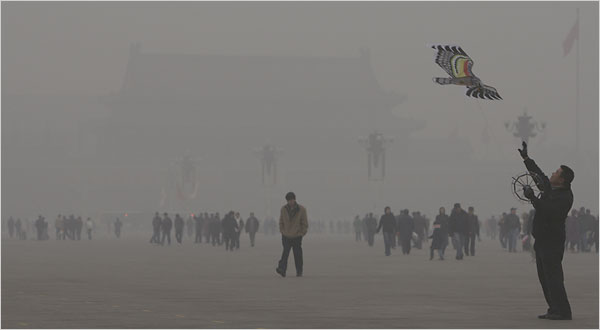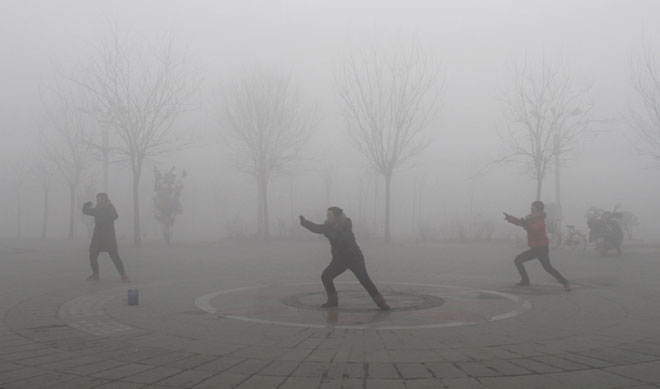Breathing in Beijing is like smoking 40 cigarettes a day
The smog that enveloped Beijing in the winter of 2012-2013 spurred the government to find a solution to the problem. Authorities have deployed a thousand stations that send measurements of six types of air pollution hourly. The level of PM2.5 microparticles settling in the lungs and causing respiratory diseases in Beijing is three times higher than the standard of the World Health Organization. Berkeley Earth's Richard Muller noted that breathing in this city is like smoking forty cigarettes a day.

Tiananmen Square, Beijing
In 2013, a special group at the Chinese Academy of Sciences found outthat I could over the capital of China by fifty percent - vehicle exhausts, smoke from burned coal and evaporation during cooking. A quarter of the particles with a diameter of less than 2.5 microns is supplied by transport, the fifth part is the soot from burning coal. Building dust plays a role in smog formation.
The authorities of the People's Republic of China have installed a thousand monitoring stations in the country, which measure, among other things, the levels of sulfur dioxide, ground- level ozone and particles up to 2.5 microns in diameter - very fine dust that is harmful to health.
For inhalation, inhalers are used for treatment, which spray the drug into drops from two to ten micrometers, so that the medicine, due to its size, freely penetrates the lungs. Dust of this size has the same property, but with it harmful substances and microbes penetrate the body.
According to GreenpeaceIn Shanghai, Guangzhou, Xi'an and Beijing in 2012, there were 8,572 premature deaths due to peaks in PM2.5 pollution. The authors of the report believe that if the PM2.5 level in these cities met the standards of the World Health Organization, there would be 81% less deaths - the economy would not lose $ 875 million. During one of the peak periods of PM2.5 increase, about ten thousand children came to one of the children's hospitals in Beijing every week for a week, one third of them due to pulmonary diseases.
According to Berkeley Earth estimates, air pollution in China is the cause of deaths of about 1.6 million inhabitants per year, which is 17% of the total number of deaths in the country. Breathing in Beijing - how to smoke forty cigarettes a day, notes the organization’s research director Richard Muller.
The World Health Organization has set standards by which the concentration of PM2.5 should not exceed twenty-five micrograms per cubic meter. According to the World Bank , in Russia this figure is ten micrograms per cubic meter, in the United States - thirteen, in the UK - fourteen. In China, the concentration of PM2.5 exceeds the norm by almost three times - an indicator equal to seventy-three micrograms.

Map of pollution of China. Dark areas are those in which the level of pollution negatively affects health.

China Daily | Reuters

Tiananmen Square, Beijing
In 2013, a special group at the Chinese Academy of Sciences found outthat I could over the capital of China by fifty percent - vehicle exhausts, smoke from burned coal and evaporation during cooking. A quarter of the particles with a diameter of less than 2.5 microns is supplied by transport, the fifth part is the soot from burning coal. Building dust plays a role in smog formation.
The authorities of the People's Republic of China have installed a thousand monitoring stations in the country, which measure, among other things, the levels of sulfur dioxide, ground- level ozone and particles up to 2.5 microns in diameter - very fine dust that is harmful to health.
For inhalation, inhalers are used for treatment, which spray the drug into drops from two to ten micrometers, so that the medicine, due to its size, freely penetrates the lungs. Dust of this size has the same property, but with it harmful substances and microbes penetrate the body.
According to GreenpeaceIn Shanghai, Guangzhou, Xi'an and Beijing in 2012, there were 8,572 premature deaths due to peaks in PM2.5 pollution. The authors of the report believe that if the PM2.5 level in these cities met the standards of the World Health Organization, there would be 81% less deaths - the economy would not lose $ 875 million. During one of the peak periods of PM2.5 increase, about ten thousand children came to one of the children's hospitals in Beijing every week for a week, one third of them due to pulmonary diseases.
According to Berkeley Earth estimates, air pollution in China is the cause of deaths of about 1.6 million inhabitants per year, which is 17% of the total number of deaths in the country. Breathing in Beijing - how to smoke forty cigarettes a day, notes the organization’s research director Richard Muller.
The World Health Organization has set standards by which the concentration of PM2.5 should not exceed twenty-five micrograms per cubic meter. According to the World Bank , in Russia this figure is ten micrograms per cubic meter, in the United States - thirteen, in the UK - fourteen. In China, the concentration of PM2.5 exceeds the norm by almost three times - an indicator equal to seventy-three micrograms.

Map of pollution of China. Dark areas are those in which the level of pollution negatively affects health.

China Daily | Reuters
